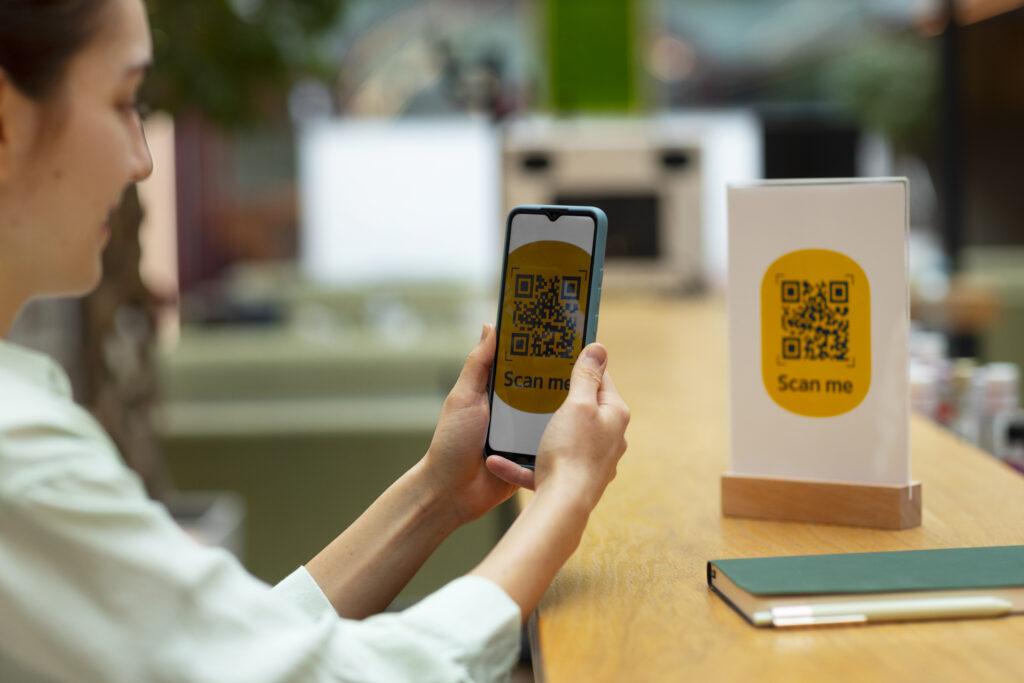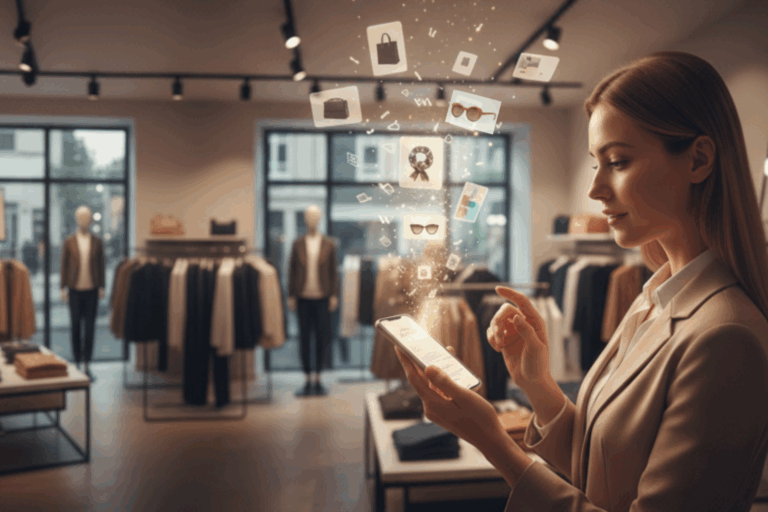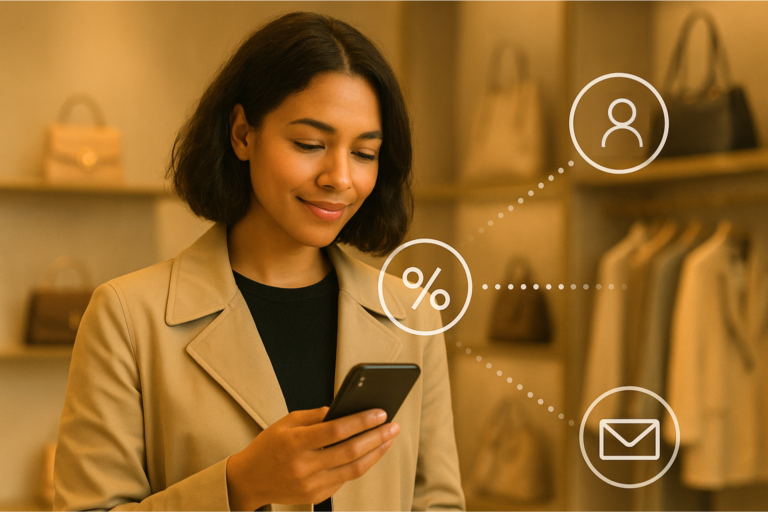Most retailers treat QR codes like that reliable friend who shows up to every party but never gets invited to the interesting conversations. They’re everywhere – on receipts, product tags, window displays – yet somehow they’re simultaneously the most overlooked opportunity in your customer engagement toolkit.
Here’s the thing: while you’ve been debating whether customers will actually scan them (spoiler: they will), your competitors might already be using QR codes in retail to bridge the gap between browsing and buying, between anonymous footfall and identified customers.
It’s 2025, and it’s time we talked about QR codes as more than just “those square things that link to websites.”
Alright, let’s begin.
What QR Codes Actually Do in a Modern Retail Context
Forget the textbook definition. In retail, QR codes in retail are your customer identification system, your engagement trigger, and your attribution tracker rolled into one. The “scan moment” is where anonymous browsers become known customers, where in-store interest connects to online behavior, and where you finally answer the question: “Did that social media campaign actually drive store visits?”
The difference between 2020 and 2025 isn’t just that more people know how to scan QR codes. It’s that the technology behind them has evolved. Dynamic QR codes now integrate seamlessly with your POS, CRM, and inventory systems. They personalize in real-time based on customer profiles, track campaign performance down to individual interactions, and enable experiences that feel native rather than bolted-on.
When a customer scans a QR code on your product packaging, they’re not just accessing information – they’re potentially joining your loyalty program, adding items to their digital wishlist, or connecting their in-store visit to their online browsing history.
That’s the strategic value most retailers are missing.
How QR Codes Work in Your Retail Operations
I have to mention that they’re not magic (Oh no). They don’t suddenly make your customers more loyal, your shelves tidier, or your promotions more effective – unless they’re integrated into the way your store actually runs. Done right, they become invisible infrastructure, quietly connecting your physical space to your digital systems.
Static vs dynamic: Know your squares
Static QR codes are the retail equivalent of printed flyers – once they’re out there, they’re fixed. Dynamic QR codes? Those are the living, breathing version. They let you change the destination link without reprinting anything, track every scan, and personalise the landing page in real time.
Here’s an example. You launch a weekend sale. On Monday, that same QR code can redirect to your loyalty sign-up or a new product launch without touching the signage.
Where they plug in
Once you start weaving them into daily operations, they become surprisingly versatile.
On the shop floor, they can live on product tags to show live stock availability or colour options, on promotional signage that can switch offers instantly, and at checkout to make loyalty sign-ups painless.
And no, no. The goal isn’t QR codes everywhere – it’s QR codes where they solve real customer friction.
Customer interaction should feel effortless. A well-designed QR code experience loads quickly, provides immediate value, and offers clear next steps.
Data capture and integration
The power comes from how they connect the dots. Every scan generates data: timestamp, location, device type, and if the customer identifies themselves, it connects to their profile. This data flows into your customer analytics, informing everything from inventory decisions to marketing campaign optimization.
Again, not just data. Useful data.

Why QR Codes Matter for Retail Strategy
If you still think QR codes are a marketing afterthought, you’re missing the point and possibly missing customers you’ve already paid to get through the door.
They’re a frontline tool for connecting offline moments to your wider retail strategy, and the difference they can make is measurable.
Every scan is a bridge between the store floor and your digital channels. Someone browses in-store, scans a product tag, and suddenly you know who they are, what they’re interested in, and how to keep talking to them long after they’ve left. That “scan moment” fuels your CRM, enriches your audience profiles, and gives you the kind of attribution data that used to be impossible for brick-and-mortar retail.
In fact, global QR code usage is set to be growing by 22% in 2025, reflecting its expanding role in connecting offline and online customer experiences.
QR codes also plug straight into the big retail shifts happening in Europe right now. With paper reduction mandates gaining traction in France and Germany, they can deliver receipts, product info, or warranty details without killing more trees.
Also Read: Digital Receipts vs Paper Receipts: What’s Best for Modern Retailers?
They can be designed to collect consent and data in a way that’s transparent and compliant. And let’s not forget customer behaviour. That’s the holy grail. Shoppers expect to engage with your brand in a way that’s instant, personal, and requires zero app downloads.
And here’s a bonus: operational efficiency improves when QR codes take routine questions off your team’s plate. Instead of fielding endless “Is this gluten free?” or “How do I wash this?” queries, staff can focus on higher-value interactions while customers get instant answers.
The strategic value isn’t in the square itself – it’s in the ecosystem you build around it. Ignore QR codes, and you’re leaving valuable data – and revenue – on the table. Yikes.
Common QR Code Mistakes in Retail (Check Yourself Before You Wreck Yourself!)
They seem deceptively simple, but we promise you – they’re not. When execution is botched, the idea misses the mark completely.
One of the biggest crimes? Generic linking. If your QR code just dumps people on your homepage, you’ve made them do the digital equivalent of opening a door that leads to a brick wall. Every scan should land exactly where the customer needs to go – an offer, more information, an opportunity to give you feedback, or collect points.
Then there’s poor visual design. Yes, QR codes are functional, but that doesn’t mean they should look like an afterthought stuck on with duct tape. Poor contrast, clashing colours, or overdesigned patterns that confuse scanners are fast ways to kill engagement. Make them feel part of your brand aesthetic.
Placement and accessibility is another silent killer. Tiny codes tucked into the bottom corner of a poster, hidden behind reflective glass, or positioned so low customers have to do a full squat to scan… let’s just say it’s not the best look. If they can’t find it or scan it without acrobatics, they won’t bother.
And please – measure the performance. If you’re not tracking scans, conversion rates, and follow-up actions, your QR codes are basically expensive stickers. Link them to your CRM, set up analytics, and use the insights to make your next campaign sharper.
Avoid these mistakes, and your QR codes shift from being dead weight to becoming one of the most versatile tools in your retail playbook.
Also Read: How to Fix the Broken Customer Journey Between Store and Screen

How the Pros Do QR Codes
If you want to know what “good” QR codes in retail look like, skip the theory and look at what’s happening on the shop floor.
Take PUMA. By linking dynamic QR codes directly to its CRM and loyalty flows, they let customers join the Puma “My Account” ecosystem in seconds. Now, 42% of customers provide marketing opt-ins.
Then there’s Gusti Leder. Their checkout QR code became the launchpad for a fully interactive digital receipt experience. Within five months, the rollout across 29 stores generated over 2,300 newsletter signups and 2,200 feedback submissions, with some locations seeing engagement rates above 40%.
(Quite a) Long story short? Best-in-class QR codes are:
- Dynamic and measurable
- Visible and intentional
- Integrated and valuable
- Frictionless for the customer
- Compliant and trustworthy
Every square you print is telling your customers something. It’s either saying “scan me for something worth your time”… or “I’m just here because marketing said so.”
If you’ve made it this far, you probably don’t want to be in the second camp.
Whether you’re chasing cleaner customer data, smoother in-store engagement, or a better way to link your physical and digital channels, maybe it’s time we had a chat.
We have a lot of good ideas you can put to work.
- How can retailers use QR codes in-store effectively?Place QR codes where they solve customer needs - for example, leaving feedback at checkout, getting a digital receipt after purchase, or accessing product details on shelves. Use dynamic codes to update content, track every scan, and keep experiences fast, mobile-friendly, and clearly valuable.
- What’s the best way to connect a QR code to a loyalty program?Use dynamic QR codes for one-click enrollment without apps. Customers can join in seconds via a post-purchase digital receipt or in-store touchpoint, enabling instant profile creation, progressive data capture, and seamless reward tracking.
- How do you measure the ROI of QR codes in retail?Track scans, sign-ups, and purchases linked to QR interactions. Integrate with your CRM or POS for accurate attribution. Factor in cost savings from reduced printing, better data capture, and increased loyalty engagement to get the full picture of return on investment.
- Are QR codes worth it for small retail stores?Yes. They’re a low-cost, flexible way to improve service and store engagement. A few well-placed codes can collect feedback, deliver digital receipts, or provide product info without extra staff time, all while capturing valuable customer data for future campaigns.
- Are QR codes GDPR compliant for European retailers?Yes, if implemented correctly. When collecting personal data, clearly state how it will be used, get explicit consent, and store it securely. Add privacy notices on signage or landing pages, and use tools that log and manage consent automatically.









